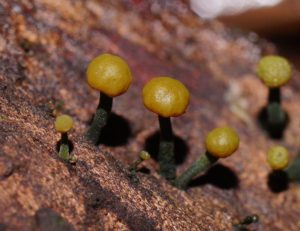
An Australasian Fungi Red List Workshop will be held in Melbourne, at Royal Botanic Gardens Victoria, 22-26 July 2019, organised by the Australasian Mycological Society Conservation Group.
The purpose of the workshop is to carry out formal threat assessments of fungi from Australasia. The aim is to formally assess around 100 species of fungi, using the IUCN Red List criteria, focussing on species endemic to the region.
We will be using the Global Fungal Red List Initiative (GFRLI) website to compile information on candidate species. Prior to the workshop, the aim is to have as much information compiled on the GFRLI website, so that the week of the workshop can be used to make and finalise the formal assessments.
What you can do now:
• Think about candidate species for assessment, and let us know. Which are the rarest fungi, what fungi are restricted to rare hosts or habitats, or hosts or habitats that are declining?
• Put your hand up to create pages on the GFRLI website for particular species an act as the main point of contact for that species.
We can provide training in advance on using the GFRLI website.
Please contact us if you would like to suggest species, or if you would like to attend the workshop in July. There is no fee to attend and some support for travel is likely to be available due to generous sponsorship by the IUCN and the Mohamed Bin Zayed Conservation Fund.
Contacts: Tom May (RBGV Victoria) & Peter Buchanan (Manaaki Whenua – Landcare Research)
You can read more about initiatives and progress in conserving fungi in the section on Conservation of fungi in the State of the World’s Fungi report, released by Royal Botanic Gardens, Kew.
Reference: Dahlberg, A. & Mueller, G. M. (2011). Applying IUCN red-listing criteria for assessing and reporting on the conservation status of fungal species. Fungal Ecology 4: 147–162.
Background
The International Union for the Conservation of Nature (IUCN) has a standardised methodology for assessing the threat status of living species. Assessments use information on the number of individuals and the distribution area, along with knowledge of declines in numbers of individuals, or their habitat. The IUCN has developed detailed criteria for assessments. Assessments can lead to formal listing on the IUCN Red List of Threatened Species. Categories include Critically Endangered, Endangered and Vulnerable, and species may also be assessed as Data Deficient or of Least Concern.
For a long time, fungi were not considered when making threat assessments, due to perceived difficulties in estimating the number of individuals. Anders Dahlberg and Greg Mueller have developed methods for estimating numbers of individuals of a fungus, taking into account current knowledge of fungal biology — that enable threat assessments to be undertaken. In addition, distribution data is becoming more readily available, through portals such as the Atlas of Living Australia, and much more extensive, due to activities of citizen science initiatives such as Fungimap.
There are more than 1.5 million records of fungi from Australia in the ALA, and for some individual Fungimap target species there are more than 3,000 records – for example, Mycena interrupta. This means that when we have very few records (especially for Fungimap target species), we can be confident that the species is rare — such as for Chlorovibrissea bicolor, known from only 26 records from a small number of sites, typically in very wet forest.
The Global Fungi Red List Initiative aims to carry out assessments of fungi, using the IUCN criteria. Information on each species is compiled on the GFRLI website, and then used for assessments. As a result, already, more than 50 fungi have been formally included on the IUCN Red List of Threatened Species. Three species from Australasia are listed: two that occur only in New Zealand (Boletopsis nothofagi and Lactarius novae-zelandiae) and Claustula fischeri, known from Australia and New Zealand.
In Australia, a common assessment method (CAM) has recently been introduced for national and state threat assessments, that is based on the IUCN criteria. It is therefore timely to be carrying out threat assessments of fungi from our region, using the IUCN criteria.

